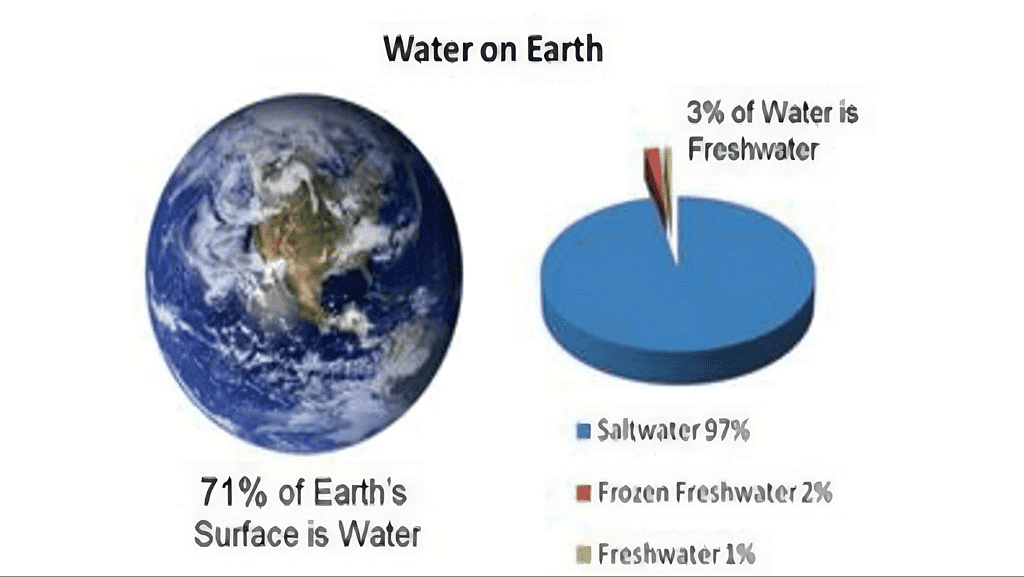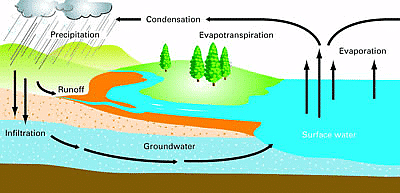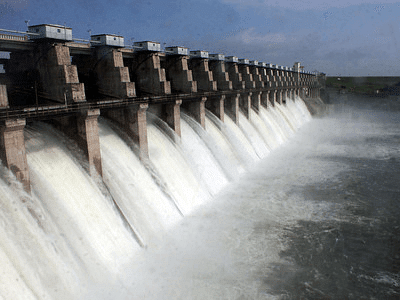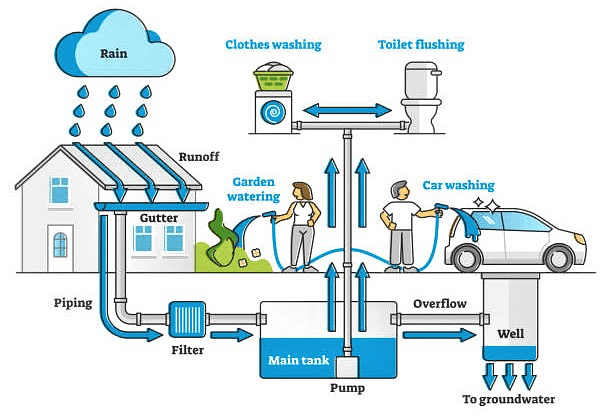Class 10 Geography Chapter 3 Notes - Water Resources
Understanding Earth's Water Resources
Earth's surface is primarily covered by water, with approximately three-fourths of the planet's surface covered by it. However, only a small fraction of this vast water resource is freshwater that can be utilized by humans for various purposes.
 Water covers 71% of Earth's Surface. Of that 97% is salt water, and only 3% is fresh water.
Water covers 71% of Earth's Surface. Of that 97% is salt water, and only 3% is fresh water.
- Sources of Freshwater: The main sources of freshwater are surface runoff and groundwater, both of which are part of the Earth's hydrological cycle. Water's presence in the hydrological cycle means that it is a resource that can be naturally restocked over time.
- Hydrological Cycle: The hydrological cycle is a continuous natural process where water evaporates from various water bodies (like oceans, lakes, and rivers), forms clouds, falls as precipitation, and flows back into these water bodies. This cycle ensures that water is constantly renewed and recharged, making it a renewable resource.
- Water Scarcity Concerns: Despite the vast amount of water on Earth and its renewability, many regions and countries worldwide face water scarcity issues.
Water Scarcity and the Need for Water Conservation and Management
- Despite water's apparent abundance and renewability, the threat of water scarcity exists.
- Commonly, water shortages are associated with regions of low rainfall or those prone to drought, like the deserts of Rajasthan.
- However, water scarcity is often due to over-exploitation, excessive use, and unequal access among different societal groups rather than availability alone.
- Freshwater can be obtained from precipitation, surface runoff, and groundwater as per the hydrological cycle.
 Groundwater Movement
Groundwater Movement
- The growing population requires more water for domestic use and food production, leading to over-exploitation of water resources for irrigated agriculture.
- The need for increasing food-grain production has led to the expansion of irrigated areas for dry-season agriculture, with irrigated agriculture being the biggest consumer of water.
- There is a need to revolutionize agriculture by developing drought-resistant crops and dry farming techniques to mitigate water scarcity.
- Also, Post-Independence India has experienced significant industrialization and urbanization, leading to abundant opportunities.
- The rapidly growing number of industries is putting pressure on existing freshwater resources, as industries use much water and power.
- Hydroelectric power, a significant energy source for industries, accounts for about 22% of the total electricity produced in India.
- Increasing urban centers with dense populations have also increased the demand for water and energy, intensifying the problem.
- Despite the quantitative aspects of water scarcity, there are situations where water is available in sufficient quantities. Still, its quality is poor due to pollution from domestic and industrial waste, chemicals, pesticides, and fertilizers.
- The Indian government has prioritized improving people's quality of life and ease of living, especially in rural areas, through initiatives like the Jal Jeevan Mission (JJM).
- JJM aims to provide every rural household with a regular supply of potable piped water.
- Lately, there is a rising worry that although there is enough water for people's needs, much of it might be contaminated by household and industrial waste, chemicals, pesticides, and fertilizers used in farming, making it dangerous for human consumption.
- The Government of India has given top priority to enhancing the quality of life and improving living conditions, especially for individuals in rural areas, through the introduction of the Jal Jeevan Mission (JJM).
- The aim of JJM is to ensure that each rural household receives a reliable supply of clean piped water at a level of 55 liters per person per day consistently over the long term by guaranteeing the functionality of the tap water connections.
- JJM aims to provide every rural household with a regular supply of potable piped water.
Multi-Purpose River Projects and Integrated Water Resources Management
Archaeological and historical records demonstrate that since early days, humans have been creating advanced water systems such as sturdy stone dams, water storage areas like lakes, raised banks, and channels for watering crops.
Hydraulic Structures in Ancient India
- In ancient times, Sringaverapura near Allahabad had a clever system for collecting water from the river Ganga when it flooded.
- Chandragupta Maurya's era saw the construction of dams, lakes, and irrigation systems on a large scale.
- Advanced irrigation structures have been discovered in various places like Kalinga (Odisha), Nagarjunakonda (Andhra Pradesh), Bennur (Karnataka), and Kolhapur (Maharashtra).
- The 11th Century witnessed the creation of Bhopal Lake, one of the biggest artificial lakes at that time.
- In the 14th Century, Iltutmish built the tank in Hauz Khas, Delhi, to provide water to the Siri Fort area.
1. Dams
Dams are built not just for irrigation but for electricity generation, water supply for domestic and industrial uses, flood control, recreation, inland navigation and fish breeding. 
Hence, dams are now referred to as multi-purpose projects where the many uses of the impounded water are integrated with one another.
For example, in the Sutluj-Beas river basin, the Bhakra – Nangal project water is being used both for hydel power production and irrigation. Similarly, the Hirakund project in the Mahanadi basin integrates water conservation with flood control.
Structure of Dams
- A dam is a wall built across a river or stream to block, control, or slow down the flow of water. This often creates a reservoir or lake behind it. “Dam” refers to the reservoir rather than the structure.
- Most dams have a section called a spillway or weir over which or through which it is intended that water will flow either periodically or continuously. Dams are classified according to structure, intended purpose or height.
- Based on the structure and the materials used, dams are classified as timber dams, embankment dams or masonry dams, with several subtypes. According to the height, dams can be categorised as large dams and major dams or alternatively as low dams, medium height dams and high dams.
 Hirakud Dam
Hirakud Dam
Uses of Dams

- It is used in Irrigating the fields.
- Used in Electricity Generation: In the Sutlej-Beas River Basin, The Bhakra- Nangal Dam is used widely for hydel power production and irrigation.
- Used as a Water supply for domestic purposes.
- Used to Supply water for industries and manufacturers.
- Used in Flood Control:- The Hirakud Dam in the Mahanadi basin is used for flood control.
- Used for Recreational purposes like water parks.
- Used in Inland Navigation.
- Used in Fish Breeding.
Disadvantages of Dams
- Construction of the Dam interrupted the flow of water, which caused the irregular flow of sediments, increasing the sedimentation in the reservoir, which made the livelihood of aquatic animals quite difficult. The dam led to fragmented rivers, which made the migration of aquatic organisms difficult.
- Local People started getting displaced from their land.
- Due to high water availability, all farmers preferred commercial crops, which caused an ecological imbalance.
- There was an increase in the social gap as they caused disputes among the people wanting their water needs to get prioritized. Even inter-state disputes became common.
- Flood control dams triggered floods as well because of the sedimentation in the reservoir. When excessive rainfall occurred, dams failed to control floods. The release of water from dams caused floods many times.
- Land degradation: Other than the loss of lives and properties, the flood also eroded soil.
2. Change in Cropping Pattern
- Irrigation has also changed the cropping pattern of many regions, with farmers shifting to water-intensive and commercial crops.
- This has great ecological consequences like salinisation of the soil.
- At the same time, it has transformed the social landscape i.e. increasing the social gap between the rich landowners and the landless poor.
- As we can see, the dams created conflicts between people who wanted different uses and benefits from the same water resources.
Pradhan Mantri Krishi Sinchaee Yojana
- Some of the main goals of this program aim to improve the access to water on farms and increase the area available for farming with reliable irrigation (every field getting water).
- Enhance the efficiency of water usage on farms to reduce waste and make water more accessible for longer periods and larger areas.
- Implement irrigation techniques and other technologies that save water (more crops per drop).
- Introduce sustainable methods for conserving water.
Rainwater Harvesting
Rainwater harvesting (RWH) is the collection and storage of rainwater rather than allowing it to run off.
Rainwater is collected from a roof-like surface and redirected to a tank, cistern, deep pit (well, shaft, or borehole), aquifer, or reservoir with percolation so that it seeps down and restores the groundwater. 
Rooftop rainwater is collected using a PVC pipe.
- Filtered using sand and bricks
- Underground pipe takes water to sump for immediate usage
- Excess water from the sump is taken to the well
- Water from the well recharges the underground
- Take water from the well (later)
In the semi-arid and arid regions of Rajasthan, particularly in Bikaner, Phalodi and Barmer, almost all the houses traditionally had underground tanks or tank for storing drinking water. The tanks could be as large as a big room; one household in Phalodi had a tank that was 6.1 metres deep, 4.27 metres long and 2.44 metres wide.
 Rainwater Harvesting
Rainwater Harvesting
- The tanks were part of the well-developed rooftop rainwater harvesting system and were built inside the main house or the courtyard.
- They were connected to the sloping roofs of the houses through a pipe.
- Rain falling on the rooftops would travel down the pipe and be stored in these underground ‘tankas’.
- The first spell of rain was usually not collected as this would clean the roofs and the pipes.
- The rainwater from the subsequent showers was then collected.
- The rainwater can be stored in the tanks till the next rainfall making it an extremely reliable source of drinking water when all other sources are dried up, particularly in the summers.
- Rainwater, or palar pani, as commonly referred to in these parts, is considered the purest form of natural water.
- Many houses constructed underground rooms adjoining the ‘tanka’ to beat the summer heat as it would keep the room cool.
- Roof top rainwater harvesting is the most common practice in Shillong, Meghalaya.
- It is interesting because Cherapunjee and Mawsynram situated at a distance of 55 km from Shillong receive the highest rainfall in the world, yet the state capital Shillong faces an acute shortage of water.
- Nearly every household in the city has a rooftop rainwater harvesting structure. Nearly 15-25 per cent of the total water requirement of the household comes from rooftop water harvesting.
Bamboo Drip Irrigation System
- In Meghalaya, a 200-year-old system of tapping stream and spring water by using bamboo pipes is prevalent.
- About 18-20 litres of water enters the bamboo pipe system, gets transported over hundreds of metres, and finally reduced to 20-80 drops per minute are the site of the plant.
 Bamboo Drip Irrigation System
Bamboo Drip Irrigation System - Tamil Nadu is the first and the only state in India which has made the rooftop rainwater harvesting structure compulsory to all the houses across the state.
- There are legal provisions to punish the defaulters rainwater harvesting system which is adapted here.
- Gendathur receives annual precipitation of 1,000 mm, and with 80 per cent of collection efficiency and of about 10 fillings, every house can collect and use about 50,000 litres of water annually.
- From the 20 houses, the net amount of rainwater harvested annually amounts to 1,00,000 litres.
|
63 videos|445 docs|87 tests
|
FAQs on Class 10 Geography Chapter 3 Notes - Water Resources
| 1. What is water scarcity and why is it a concern for many regions? |  |
| 2. How can water conservation be achieved in daily life? |  |
| 3. What are multi-purpose river projects and their benefits? |  |
| 4. What is rainwater harvesting and how does it work? |  |
| 5. What is the bamboo drip irrigation system and its advantages? |  |

|
Explore Courses for Class 10 exam
|

|



















